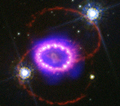Speaker
Dr
Rino Bandiera
(INAF - Osservatorio Astrofisico di Arcetri)
Description
Bamba et al. (2010) used deep X-ray observations, with Chandra and Suzaku, to
estimate the sizes of faint and old Pulsar Wind Nebulae (PWNe). They found a steady
increase in size with the nebular age, up to ages of about 10^5 yr. Their conclusion
was that these PWNe keep expanding up to large ages, in apparent contradiction
with the idea that a reverse shock from the associated supernova remnant squeezes
the PWN before the beginning of the Sedov phase. As a consequence, in order to
allow X-ray emitting electrons to reach large distances from the pulsar without being
burnt by synchrotron losses, they infer a very weak nebular magnetic field and/or
that these electrons are diffusing out efficiently.
I propose a different scenario, in which the observed trend arises from the
combination of objects expanding under a wide range of ambient densities. Older
PWNe re-brighten considerably near the time at which they are compressed by the
reverse shock, and this represents for many of them the last chance to become
detectable. But the time at which this phase takes place also depends on the
ambient medium density, and it can be shown that the observed trend is naturally
reproduced, by assuming reasonable values for the supernova and pulsar initial
conditions.
Using this scenario, also the correlation found by Mattana et al. (2009) between the
X-ray PWN flux and the pulsar spin-down luminosity can be reproduced. It should be
noticed that they also used a sample containing several aged PWNe, with
characteristic ages up to 10^5 yr. A related effect is that, since right before the PWN
compression phase the nebular magnetic field is very low, the X-ray emitting
electrons suffer negligible synchrotron losses and then they build up a flatter energy
distribution, therefore justifying the positive correlation, discovered by Gotthelf
(2003) and confirmed by Li et al. (2008), between X-ray luminosity and X-ray
photon index.
Finally, I will discuss the statistical properties of the TeV emission in old PWNe.
Primary author
Dr
Rino Bandiera
(INAF - Osservatorio Astrofisico di Arcetri)

